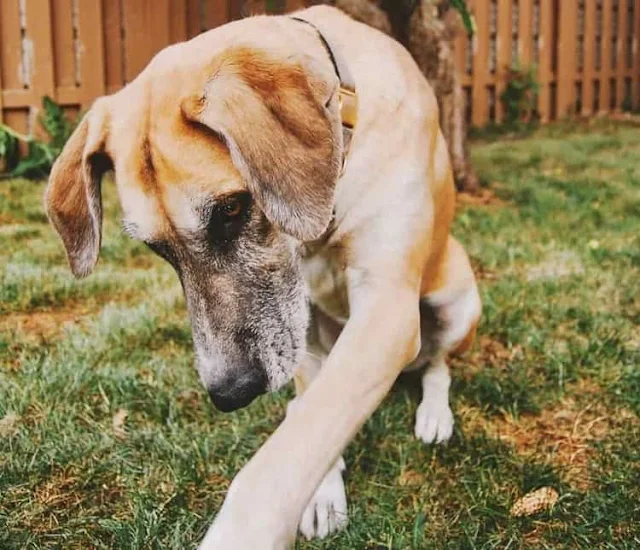Elbow dysplasia in dogs is a bone disorder that occurs during the growth phase of the puppy. Knowing its symptoms is very important to be able to treat this disease and cause the least discomfort to the animal.
What is elbow dysplasia in dogs?
When we talk about elbow dysplasia in dogs we are referring to a degenerative joint disease. It occurs because the bone tissue of the joint does not develop normally, causing first arthritis (inflammation in the joint) and then osteoarthritis (progressive wear and tear of the bony structures that give rise to the joint).
To be more specific, the elbow joint is a somewhat complex joint, made up of 3 bones: radius, ulna and humerus. When these three bones do not fit together perfectly due to an alteration in growth, there is an abnormal distribution of weight on different areas of the joint. This causes lameness and pain, and is what causes arthritis to develop.
There are two types of elbow dysplasia:
- Unilateral elbow dysplasia: the disease occurs in one of the elbows.
- Bilateral elbow dysplasia: the disease occurs in both elbows. This usually occurs in 80% of cases, as stated by professionals.
Main causes of elbow dysplasia in dogs
There are two causes of elbow dysplasia in dogs.
Genetic predisposition
The most common cause of elbow dysplasia in dogs is genetic. This means that it is a hereditary pathology, so it is not usually advisable to breed dogs with this problem.
Environmental causes
Among the environmental causes we must talk about the feeding of the puppy. When this is not adequate during the developmental stage of the puppy, it can lead to the appearance of elbow dysplasia.
In addition to this, if the dog's breed is one of those predisposed to hereditary elbow dysplasia, exercising at high intensity can make the problem even more serious.
What breeds of dogs are prone to elbow dysplasia?
As experts explain, this disease usually appears in young dogs, between 4 and 6 months of age, of medium, large and giant breeds. Some of these breeds are: the Rottweiler, the German Shepherd, the Neapolitan Mastiff, the Bernese Mountain Dog, the Newfoundland, the Labrador retriever or the Golden retriever.
One of the precautions to take into account with respect to these breeds is that, as mentioned above, exercise should be limited, avoiding rough play.
On the other hand, as far as their diet is concerned, calcium abuse should be avoided (hypercalcemia can cause bone weakness), excess protein should be controlled and a diet with chondroprotectors should be provided.
What are the signs of elbow dysplasia in dogs?
If a dog suffers from elbow dysplasia, symptoms usually appear within a few months of life (from 4 months of age, as mentioned above). However, if the osteoarthritis is not very developed, the signs may be so mild that it is very difficult to detect.
Some of the signs that will indicate that a dog has elbow dysplasia are:
- Lameness in the front legs when initiating movement.
- The dog cannot exercise, refuses to exercise, and may not even want to go for a simple walk.
- Lameness after prolonged exercise.
The only way to determine that the disease is present is to perform a medical examination and an X-ray, and a visit to the veterinary center is essential.
X-rays often show signs of arthritis, but may also reveal small bone fragments in the joint or nonunion of the ankylosing process.
In addition, a medical examination is the only way to rule out other pathologies, such as hip dysplasia.
Read also: Hip Dislocation in Dogs
How is elbow dysplasia treated in dogs?
After the detection of this pathology, the professional will determine what type of treatment is appropriate for each particular case. Usually, it is based on two options: surgical and conservative treatment.
Surgery
In very severe cases, in order to guarantee an optimal quality of life for the dog, it will be necessary to perform a surgical intervention. This may vary according to the case.
Sometimes it will be performed for the union of bone fragments with a screw, sometimes to implant a prosthesis, sometimes to remove a loose bone fragment that causes discomfort in the movement of the elbow, etc.
Conservative treatment
In dogs with less severe elbow dysplasia or that for some circumstance are not operable, a conservative treatment will be established. This consists of:
- Administration of analgesic drugs to control pain.
- Restriction of inadequate exercises.
- Administration of chondroprotectors to make the joint stronger.
- In dogs with obesity, it will be necessary to start an adequate and balanced diet to lose weight.
- The placement of an orthopedic support element, such as elbow orthoses, usually relieves pain and improves mobility.
Whatever the veterinarian's indications, as pet guardians we must follow all the recommendations to the letter so that our dog with elbow dysplasia can have the life it deserves.


